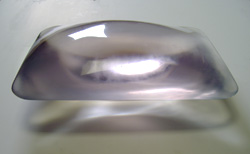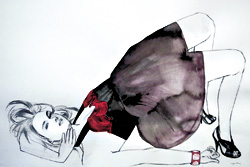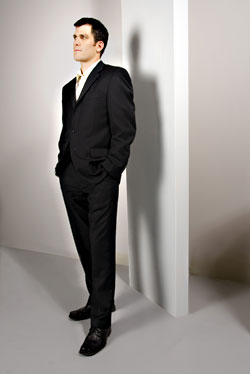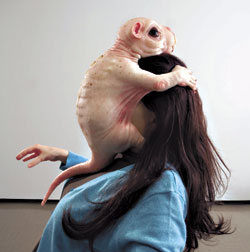Don’t let the ridiculous press release steer you away from seeing Susie Jungune Lee’s upcoming show at Lawrimore Project. (It’s marked by pompous headings like “The Best Artist’s Statement Ever” and “Oh, You Want More Hyperbole Than That?”) Though Lee only graduated from the University of Washington in 2006, her work is anything but ingenuous, a far cry from arrogant, and definitely worth experiencing.
Her debut has been stellar. At the UW’s annual Master of Fine Arts show, Lee was a beacon of hope amidst a sea of mostly tenderfooted work. It was hardly surprising that, six or so months later, when Lee debuted on the commercial scene at Aqua Art Miami—a satellite art fair that takes place every year in proximity to the largest art fair in North America, Miami Basel—her sculpture could have sold 20 times over.
In the totally chaotic settings of both the M.F.A. show and Aqua, her stunningly graceful sculpture, Consummation, made room for pause. The long wave of a 62-inch glowing panel was mesmerizing. Flitting across the length of the billowing wood, a video of the shadow of two burning strands of twine danced to the tones of a perfectly tentative Bach prelude. The smoldering gray lines were at once living sheet music for the piano piece and some sort of abstract memento mori.
Her new show, “Refrain,” will fill every one of Lawrimore’s five cavernous galleries with two ambitious installations, three new sculptural video works, and a new narrative video.Issues of recurring love and loss appear throughout the new work, and though this makes Lee’s art sound like it is draped in romantic trappings, it isn’t. Her graduate degree in art aside, Lee also has a Bachelor of Science in molecular biophysics and biochemistry from Yale University and a master’s in education from Columbia University, which means she is perfectly poised to explore the human core of emotional experience in an intellectual manner.
This proved true when I asked Lee why she wrote lyrics like “Where are you I need you here/Can’t bring you with me/Have to let you go again” for her artist’s statement. When I read them, they came off more like musing from a teenage diary than “the best artist’s statement ever,” so I had to ask. Lee’s response made her reasoning solid and hard to argue with. “I was interested in exploring the idea of the ‘resonant frequency’ of memory, in which the absence of another person compels one to remember the past over and over,” she e-mailed. “To me, time-based media unfolds as a musical composition does, and a person’s return to the past is like a song’s return to its chorus….Even as the present demands one’s attention, triggers will remind us of someone, and so we go back. Eventually we must return to now, which is, in some way, saying goodbye to that person again.”
Lee’s enduring fascination with the patterned behavior of our brains (or rather, the way we play memories over and over in our heads) makes song an apt compositional tool and the looped format of video art the most appropriate of mediums. The videos play on repeat just as our strongest memories do.
You will see this most tangibly in Four Quartets, a single-channel video that is described in the press release as a visual document of loss. As we watch four people describe what it feels like to lose someone, we see a range of emotions. The piece, whose title alludes to the seasonal cycles, and is a direct reference to T.S. Eliot, unfolds as an ebbing and flowing testament to how loss is simply a part of life, inevitable as the seasons.
Another single-channel video, Wachet auf, ruft uns die Stimme, reminds us to accept inevitable endings. With Bach’s cantata used as both the soundtrack and title of the piece, the message feels a little heavy-handed—the title translates simply to “Wake up, the voice calls us”—but visually it’s an abstracted melding of essential elements. Light, water, and oil mingle together, appearing and disappearing while the chorale echoes.
Against these explorations of emotional refrains, there is also a palpable aligning of these experiences with natural phenomena. In the main space of the gallery, for instance, Lee’s Rain Shower (Sonagi) will fill the area with artificial rain. Sounds of thunder and rain will echo above, as lines of light create what can only be described as a virtual memory of an utterly familiar experience. The installation is so skeletal and essentially pared down that just as the gallery gets flooded by the sculpture, so too do our neural pathways. Just looking at a photo of the work made me trip through a list of rain-related moments. Everything from Singing in the Rain to real-life, rain-drenched kisses invaded my brain. Lee lets you be as self-involved and self-reflective as you like.You decide.








